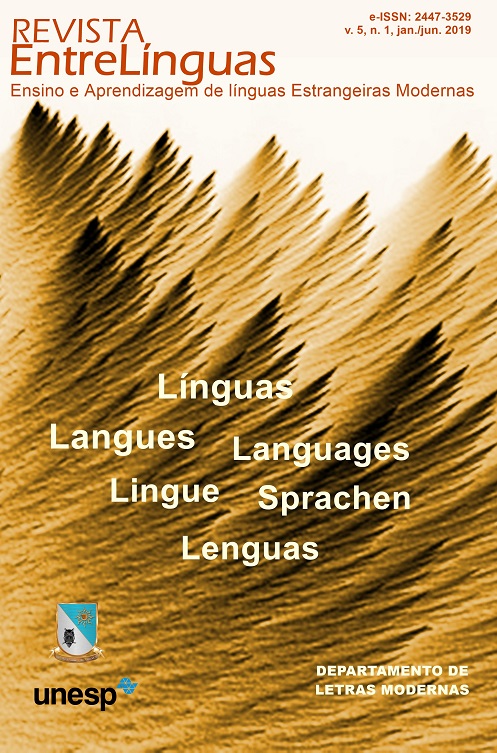Language and culture: the curriculum guidelines for teaching foreign language
DOI:
https://doi.org/10.29051/el.v5i1.12422Keywords:
Language and culture, OCEM, Linguistic policy, Speech, Teaching and learning.Abstract
The Brazilian document "Orientações Curriculares do Ensino Médio” (OCEM) values the plurality and heterogeneity of the language, the contact with the other and the reflection on cultural diversities. Therefore, the aim of this article is to verify which culture concept(s) emerges through the reading of the document and to relate how it has been understood in the teaching and learning of a foreign language. For this work, we mobilized, as a methodological and analytical framework, the concept of interdiscourse, within the scope of French Discoursive Analysis. We noticed that OCEM suggests an intrinsic work between language and culture. Such notions complete each other, due to the fact that the language is in the culture and vice-versa. Although it does not mention, the analytical retake to the interdiscourse allows the observation that the discursiveness of the document deals with several authors. This work shows such important concepts for teaching and learning languages, as well as highlighting their importance.Downloads
References
BRASIL. Secretaria de Educação Básica. Orientações curriculares para o ensino médio: linguagem, códigos e suas tecnologias. Secretaria de Educação Básica – Brasília: MEC, 2006. v.2
COPE, B.; KALANTZIS, M. Multiliteracies: literacy learning and the design of social futures. London: Routledge, 2000.
GEE, J. P. Orality and literacy: from the savage mind to ways with words. TESOL Quarterly, v. 20, n. 4, p. 720, 1986.
GEE, J. P. New people in new worlds: networks, the new capitalism and schools. In: COPE, B.; KALANTZIS, M. Multiliteracies: literacy learning and the design of social futures. London: Routledge, 2000.
GREGOLIN, M. R V. O que quer, o que pode esta língua? Teorias linguísticas, ensino de língua e relevância social. In: CORREA, d. (org.) A relevância social da Linguística: linguagem, teoria e ensino. São Paulo: Parábola / Ponta Grossa, PR: UEPG, p. 51-78, 2007.
HALLIDAY, M. Language as social semiotic. London: Edward Arnold, 1978.
KRAMSCH, C. The cultural discourse of foreign language textbooks. In: SINGERMAN, A. (Ed.). Toward a new integration of language and culture. Middlebury, VT: Northeast Conference on the Teaching of Foreign Languages, p. 63-88, 1988.
KRAMSCH, C. Context and Culture in Language Teaching. Oxford: Oxford University Press, 1993.
KRAMSCH, C. Language and culture. Oxford: Oxford University Press, 1998.
KRAMSCH, C. Intercultural Communication. In: CARTER, R.; NUNAN, D. (Eds.). The Cambridge Guide to Teaching English to Speakers of Other Languages. Cambridge: Cambridge University Press, 2001.
KUMARAVADIVELU, B. Cultural Globalization and Language Education. USA: Yale University Press, 2008.
ORLANDI, E. A Linguagem e seu Funcionamento. Brasiliense: São Paulo, 1983.
ORLANDI, E. (Org.). Análise de Discurso: princípios e procedimentos. 3. ed. Campinas: Pontes, 2001.
ORLANDI, E. Identidade Linguística Escolar. In: SIGNORINI, Inês (Org.). Lingua(gem) e Identidade: elementos para uma discussão no campo aplicado. Campinas, SP: Mercado de Letras, 2002.
ORLANDI, E. Discurso e Leitura. 8. ed. São Paulo: Cortez, 2008.
PARAQUETT, M. As dimensões políticas sobre o ensino da língua espanhola no Brasil: tradições e inovações. In: MOTA, K. M. S. SCHEYERL, D. Espaços Linguísticos: Resistências e Expansões. Salvador: EDUFBA, 2006.
SALOMÃO, A. C. B. O componente cultural no ensino e aprendizagem de línguas: desenvolvimento histórico e perspectivas na contemporaneidade. Trabalhos em Linguística Aplicada. [online]. vol. 54, n. 2, p. 361-392, 2015. ISSN 0103-1813. http://dx.doi.org/10.1590/0103-18134500150051.
SOARES, M. Letramento: um tema em três gêneros. Belo Horizonte: Autêntica, 2004.
SWALES, J. Genre Analysis. Cambridge: Cambridge University Press, 1990.
Downloads
Published
How to Cite
Issue
Section
License
Os manuscritos aceitos e publicados são de propriedade da Revista EntreLínguas. Os artigos publicados e as referências citadas na Revista EntreLínguas são de inteira responsabilidade de seus autores.
Transferência de direitos autorais – autorização para publicação
Caso o artigo submetido seja aprovado para publicação, já fica acordado que o(s) autor(es) autoriza(m) a UNESP a reproduzi-lo e publicá-lo na EntreLínguas, entendendo-se os termos “reprodução” e “publicação” conforme definição respectivamente dos incisos VI e I do artigo 5° da Lei 9610/98. O artigo poderá ser acessado pela rede mundial de computadores (Internet), sendo permitidas, a título gratuito, a consulta e a reprodução de exemplar do artigo para uso próprio de quem a consulta, desde que haja a citação ao texto consultado. Essa autorização de publicação 328 EntreLínguas, Araraquara, v. 1, n .2, p. 323-328, jul./dez. 2015 não tem limitação de tempo, ficando a UNESP responsável pela manutenção da identificação do(s) autor(es) do artigo. Os artigos publicados e as referências citadas na Revista EntreLínguas são de inteira responsabilidade de seus autores.











